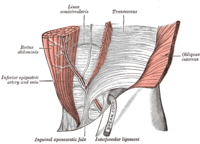
Photo from wikipedia
BACKGROUND Transversus Abdominis Release (TAR) during ventral hernia repair (VHR) allows for further lateral dissection by dividing the transversus abdominis muscles (TAM). The implications of division of the TAM on… Click to show full abstract
BACKGROUND Transversus Abdominis Release (TAR) during ventral hernia repair (VHR) allows for further lateral dissection by dividing the transversus abdominis muscles (TAM). The implications of division of the TAM on clinical and patient-reported outcomes has not be extensively studied. METHODS Adult patients undergoing retrorectus (RR) VHR with biosynthetic mesh with or without bilateral TAR were retrospectively identified. Post-operative and patient-reported outcomes (PROs) were collected. RESULTS Of 50 patients, 24 underwent TAR and 26 had RR repair alone. Median defect sizes were 449 cm2 and 208 cm2, respectively (p < 0.001). Rates of SSO and SSI were similar (p > 0.05). One TAR patient (4.2%) and four RR patients (15.4%) recurred (p = 0.26), with median follow up of 24 and 38 months. PROs improved significantly in both groups (p < 0.05). CONCLUSION Despite more complex abdominal wall reconstruction on larger defects, TAR has minimal major adverse events, low recurrence rates, and does not negatively affect PROs.
Journal Title: American journal of surgery
Year Published: 2021
Link to full text (if available)
Share on Social Media: Sign Up to like & get
recommendations!